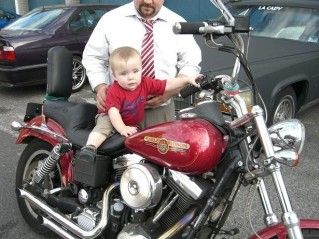I'm with Black and a carb re-build will probably correct the problem.
Another thing to remember is that carberated motors even when tuned correctly will pop on decel under certain conditions. For instance if you completely decel on down hill from a high RPM, you can expect some popping or backfiring.
A couple of questions are:
1) Is it a popping like a "pop... pop.pop" or a true back fire "BANG"!
2) Does it do it everytime you decelerate?
3) Does it only do it on a complete decel - from speed to completely shutting down the throttle, or does it do it when you just partially decelerate?
Depending on your answers, some of what you are experiencing may be completely normal. Here is a great write-up I got when back in school
Deceleration backfire, or “popping”. This topic generates a lot of concern from inexperienced riders, or even from experienced guys who just hate the noise, so lets take a look at what causes it. But first things first, lets define the issue:
Deceleration Backfire is caused by fuel burning in the exhaust manifold or header.
No ifs ands or buts, that’s what causes it. But the bigger question is how does gas get there in the first place, and that’s a bit more complicated. Generally, there are a variety of ways it gets there, and a variety of things that can make the backfiring worse. But there’s a kicker, and something you should understand before we go any farther:
Even a motor in perfect tune may occassionally exhibit deceleration backfiring.
Therefore, just because your motor is banging it up, doesn’t mean there’s anything wrong. And consequently:
Getting rid of the noise may mean de-tuning your motor.
Yup. If you’ve jut got to eliminate that popping, you’ll have to accept the fact that your motor is going to be forced to run rich to do it, and that isn’t necessarily a good thing. So lets talk about what causes the problem.
Ok, so you’re riding along at some given rpm, and suddenly you decide to decelerate, and you reduce the amount of throttle. This causes an “overrun” – that is, the motors rpm is turning faster than the fuel provided can support, so the motor begins to spool down. This causes a couple of things to happen.
First, when you close the throttle, you are also closing the throttle plates. This reduces the air and fuel flowing into the motor, and increases the vacuum (lowers the pressure). This results in less air and fuel in the cylinder during the power stroke, which in turn results in a lower pressure in the combustion chamber. Remember I said earlier, that the A/F mix burns faster in proportion to the pressure applied? Well, when we reduce pressure this way, the mix burns slower. This results in two things happening.
1. The lower burning fuel generates less heat, and the cooling effect of the non-burning fuel tends to “quench” the flame front, or slow it down even further. Because the mix is burning much slower, the exhaust valve can open before all the fuel is consumed, and the unburnt fuel is ejected into the exhaust.
2. The engine designers, in order to promote smoother idling and better combustion, retard the spark when the throttle is shut, and this results in the mix being lit later.
So, now we end up with unburnt fuel in the exhaust, and burning fuel being ejected into the exhaust, and bang! Backfire. In addition, Honda has added a device called a “programmed air injection valve” (Pair Valve) that actually injects some fresh air into the exhaust to help this process along – since fully burning the fuel results in cleaner exhaust. So the backfiring is not only a normal part of the engines operation, it’s also intentionally amplified by Honda! Of course, normally, that massive bazooka pipe Honda hangs on your bike hides most of the noise, but it’s there, even when you can’t hear it.
So the bottom line, is: That backfiring is perfectly normal and expected. If you’ve just got get rid of it, that’s up to you. You’re entitled to set your motor up the way you want, and your goals are your goals. But don’t refer to it as “fixing” the popping. Rather, the correct way to think of it is “de-tuning a bit to get rid of the popping”.
There are a few ways you can do this.
First, use the stock pipe. It will hide the sound, by absorbing it into mass, and masking it with the larger baffle space. Second, you can add more fuel during deceleration. This has the effect of raising the chamber pressure slightly, which burns a little more before the exhaust valve opens.
